Chemical composition of incubation substrates and their effect on survival of cisco (Coregonus artedi) embryos
Contributing Authors
Alex Gatch (USGS, agatch@usgs.gov); Brian Weidel (USGS); Marc Chalupnicki (USGS); Gregg Mackey (USGS); Christopher Osborne (University at Buffalo); Jim Watkins (Cornell); Kristen Holeck (Cornell); Dimitry Gorsky (FWS)
Project Description
Benthic spawning habitats used by coregonine species such as cisco (Coregonus artedi) have undergone drastic changes in Lake Ontario, particularly since European colonization. Land use changes coupled with cultural eutrophication and invasive species introductions have increased sedimentation and fouling of rocky substrates used by lithophilic spawners (Furgal, 2019; Meyers, 2006; Schelske et al., 1988; Weidel et al., 2023). In Lake Ontario, cisco spawn in nearshore shoals, which are likely more degraded compared to offshore habitats lacking proximity to tributary and urban municipality inputs. Evidence suggests that cisco select rocky substrates in 2-5m to deposit embryos (Gatch et al., 2023; George et al., 2017; Paufve et al., 2022), but these habitats are largely degraded by sediment infilling and biofouling (Weidel et al., 2023). Rocky substrates infilled by sediments and other fouling (e.g., mussel hash) may have lower incubation success because chemical conditions are not appropriate to foster incubation over the 4-5-month period required for cisco. Additionally, a lack of protective interstitial spaces within rocky habitats – due to sediment infilling – may prevent cisco embryos from adhering to the substrates selected by spawning cisco, resulting in removal of cisco embryos to habitats that contain less suitable incubation conditions (e.g., silt substrates). When cisco embryos incubate in silt substrates, the resulting larval emergence is near zero in one Lake Ontario embayment (Weidel et al., 2023). In Lake Superior, however, some cisco populations have been described as ‘mud herring’ because they are thought to spawn on benthic habitats mainly comprised of silts (Goodyear et al., 1982). If cisco embryos are able to incubate in sub-optimal environments such as silt substrates, then what mechanisms allow these embryos to survive in some locations but not others?
The survival of incubating cisco embryos over sub optimal habitats may be influenced by the organic composition of benthic sediments. The organic composition of sediments can be driven by algal productivity resulting, in part, from cultural eutrophication (Meyers, 2006; Schelske et al., 1988). For example, increases in algal production can alter benthic substrates by increasing the sediment organic carbon (SOC) concentrations of the bottom sediments due to ‘marine snow’ or the process of algae settling from the water column (Turner, 2015). Additionally, microbial activity positively correlates with benthic SOC, and chemical processes associated with microbial respiration can change water chemistry (e.g., dissolved oxygen, pH, and production of hydrogen sulfide and methane) at the diffusive boundary layer (DBL) between the water-sediment interface (Colby et al., 1972; Ventling-Schwank and Livingstone, 1994). Similarly, microbial communities can significantly influence the biochemical and biophysical characteristics of their habitats (Philippot et al., 2024), but the impact of the sediment microbiome on developing fish embryos remains largely unexplored.
In Lake Ontario, restoration of coregonines is a management objective, and management agencies are evaluating tools that may be beneficial to restoration efforts (e.g., spawning habitat restoration). However, there is limited information about which areas of Lake Ontario might be suitable for such restoration efforts given the current state of spawning habitats. Historically, cisco spawned in many of the southern shore embayments (e.g., Irondequoit, Sodus, Little Sodus Bays) and were prolific enough to support a commercial fishery (George, 2019; Stone, 1938). In contemporary Lake Ontario, cisco still use these areas to spawn but are in such low densities that they are only detectable using advanced methods (eDNA; Weidel et al., 2024 GLRI coregonine project). To increase the resiliency of cisco populations in Lake Ontario to environmental changes, a diversity of spawning locations is likely necessary, but which embayments are still viable options for remediation? Experimentation with embryo translocation and ‘seeding’ is being evaluated in Lake Ontario (Weidel et al. 2024 GLRI coregonine project). Results from our study could help inform embryo seeding efforts and direct resources to areas that are more suitable than others.
We are proposing a study in which we measure productivity (indexed by water column chlorophyll-a concentration), nutrient concentrations (water column total phosphorus, soluble reactive phosphorus), DO, pH, and SOC of bottom sediments in three low use spawning areas - Irondequoit Bay, Sodus Bay, Little Sodus Bay, and one high use spawning area - Chaumont Bay. Additionally, we will collect bottom substrates from these four embayments, characterize the in-situ microbiome community, and measure incubation success of cisco embryos in a controlled laboratory setting. The results from this study could identify the mechanisms leading to embryonic mortality in silt substrates and provide helpful information for resource managers considering the location of potential spawning habitat remediation in Lake Ontario.
